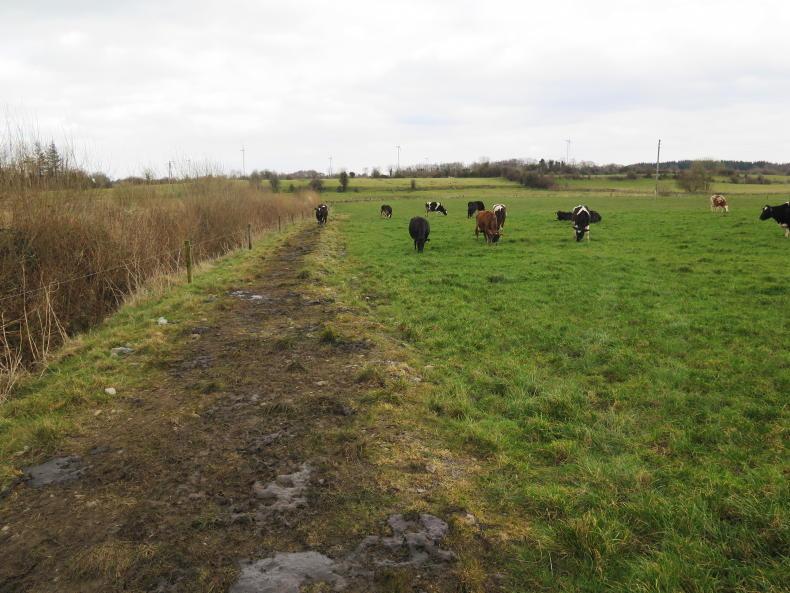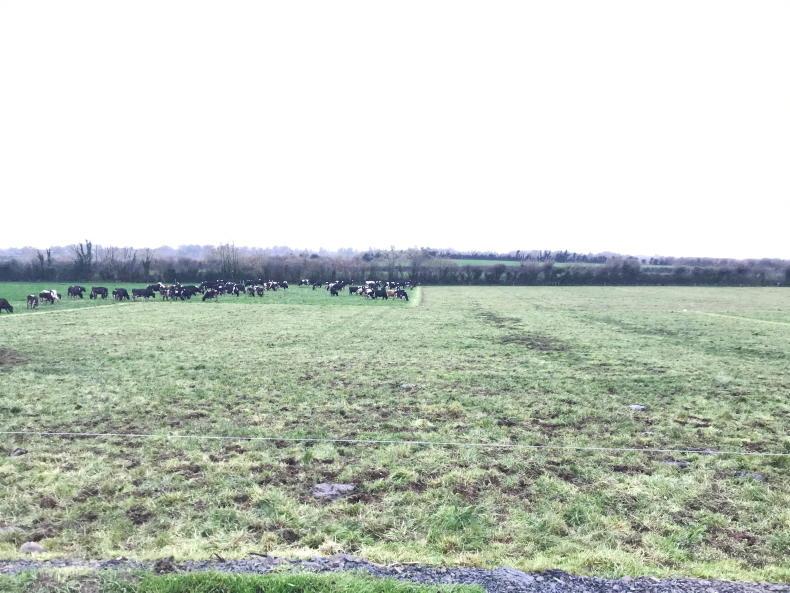Early turnout to grass is good for sustainability. It reduces costs of production, increases animal output, reduces ammonia losses and lowers the carbon footprint of farming because animals at grass feed themselves, require less imported grains and require less slurry to be spread.
As a result, extended grazing is a key part of how Irish agriculture will reduce its emissions profile.
Early turnout is challenging for farmers, not least because of weather in early spring and the fact that about 30% of farmed soils in Ireland are considered to be heavy soils and more likely to be poached or damaged.
It also takes good grassland management skills to get it right, skills that not every farmer possesses. Here, we look at some of the key steps when it comes to managing early grazing in springtime.
1. Pick the right spot
First things first, not every farm in Ireland is suitable for early spring grazing and that needs to be acknowledged at the outset.
However, more often than not, farmers consider their fields to be wetter than they actually are. There is usually a big variation in soil type within a farm, with some fields much drier than others.
Picking a field to graze in early spring is a bit of a juggling act. It’s easy on very dry farms and much more difficult on wetter farms.
Farmers who are successful at early spring grazing on those more marginal farms will always walk the farm to try and find the dry spots and avoid the wet spots.
They say that these decisions cannot be made from the farmyard and that the fields must be walked and, very often, only part of a field will be able to be grazed at that time.
2. Use a spur road
The use of spur roads will allow the farmer to get cows to almost any part of the paddock.
This is especially important when conditions are tough and cows cannot walk back over previously grazed areas, or need to get to the middle or back of a paddock to a dry spot.

Permanent spur roads give access to the wetter parts of paddocks.
The simplest approach is to make a narrow path using temporary wires. The path should be about 1m wide to minimise the damage caused to a small area, and ideally, this should be alongside a hedge or fence.
Make no mistake – this area will be badly poached, but it’s a small area and can be repaired later in the year.
Some farmers have invested in permanent spur roads, but the issue with these is knowing where to put them for maximum benefit.
3. Allocate the correct area
This is a really important skill and takes a bit of knowledge and learning to get it right. In actual fact, even the best farmers don’t get it 100% right very often, especially in early spring.

Correct allocations, as judged by ideal post-grazing yields.
The variables include: how much grass is in the field, how much grass the cows will eat, soil conditions and what the weather is like overhead. These are all things that require best estimates and need to be adjusted daily.
The following is one method used to allocate grass in early spring:
Work out how many cows are grazing and how much grass they are eating in the 12-hour break; for example, 15 cows eating 6kg is a total demand of 90kg. Cow intake is lower in spring and rises as they approach peak milk. Work out how many square metres are needed to give 1kg of grass dry matter. To do this, divide the cover into 10,000. For example, a cover of 900kg into 10,000 is 11.1m2/kg of dry matter. The higher the cover of grass, the lower the number of metres to get 1kg of dry matter. Multiply this number by the demand to work out the total allocation. So in this case, 11.1 multiplied by 90kg is ~1,000m2. This is how much area you need to give the cows. To work out where to put the fence, measure the length of the paddock and then divide this into 1,000. For example, if the paddock is 75m deep, the strip wire should be placed 13m wide. 4. Keep silage out of the diet
When conditions are good and there’s plenty of grass available, then it makes sense to keep grass in the diet and silage out of the diet.
Silage is a low-protein and low-energy feed that will suppress appetite and performance. It’s a bulky feed and if cows go out to grass with silage in their bellies, they’ll have less interest in grass.
Rather than graze vigorously, they will do more walking around and, in the process, walk grass into the ground and do more damage.
In many situations, grass can get tight on farm in late March and early April, and some silage is necessary to be fed. In my view, it’s preferential to work out how much silage is required to be fed and allocate that on an all-in or all-out basis.
For example, pick one or two wet days a week and keep cows in on silage and keep them all out on grass on the other days.
Feeding grass and silage together reduces utilisation and is more complicated to operate.
Another important point is that if weather is good enough for cows to graze during the day, then it’s dry enough to graze at night. Cows aren’t afraid of the dark or the cold.
Early turnout to grass is good for sustainability. It reduces costs of production, increases animal output, reduces ammonia losses and lowers the carbon footprint of farming because animals at grass feed themselves, require less imported grains and require less slurry to be spread.
As a result, extended grazing is a key part of how Irish agriculture will reduce its emissions profile.
Early turnout is challenging for farmers, not least because of weather in early spring and the fact that about 30% of farmed soils in Ireland are considered to be heavy soils and more likely to be poached or damaged.
It also takes good grassland management skills to get it right, skills that not every farmer possesses. Here, we look at some of the key steps when it comes to managing early grazing in springtime.
1. Pick the right spot
First things first, not every farm in Ireland is suitable for early spring grazing and that needs to be acknowledged at the outset.
However, more often than not, farmers consider their fields to be wetter than they actually are. There is usually a big variation in soil type within a farm, with some fields much drier than others.
Picking a field to graze in early spring is a bit of a juggling act. It’s easy on very dry farms and much more difficult on wetter farms.
Farmers who are successful at early spring grazing on those more marginal farms will always walk the farm to try and find the dry spots and avoid the wet spots.
They say that these decisions cannot be made from the farmyard and that the fields must be walked and, very often, only part of a field will be able to be grazed at that time.
2. Use a spur road
The use of spur roads will allow the farmer to get cows to almost any part of the paddock.
This is especially important when conditions are tough and cows cannot walk back over previously grazed areas, or need to get to the middle or back of a paddock to a dry spot.

Permanent spur roads give access to the wetter parts of paddocks.
The simplest approach is to make a narrow path using temporary wires. The path should be about 1m wide to minimise the damage caused to a small area, and ideally, this should be alongside a hedge or fence.
Make no mistake – this area will be badly poached, but it’s a small area and can be repaired later in the year.
Some farmers have invested in permanent spur roads, but the issue with these is knowing where to put them for maximum benefit.
3. Allocate the correct area
This is a really important skill and takes a bit of knowledge and learning to get it right. In actual fact, even the best farmers don’t get it 100% right very often, especially in early spring.

Correct allocations, as judged by ideal post-grazing yields.
The variables include: how much grass is in the field, how much grass the cows will eat, soil conditions and what the weather is like overhead. These are all things that require best estimates and need to be adjusted daily.
The following is one method used to allocate grass in early spring:
Work out how many cows are grazing and how much grass they are eating in the 12-hour break; for example, 15 cows eating 6kg is a total demand of 90kg. Cow intake is lower in spring and rises as they approach peak milk. Work out how many square metres are needed to give 1kg of grass dry matter. To do this, divide the cover into 10,000. For example, a cover of 900kg into 10,000 is 11.1m2/kg of dry matter. The higher the cover of grass, the lower the number of metres to get 1kg of dry matter. Multiply this number by the demand to work out the total allocation. So in this case, 11.1 multiplied by 90kg is ~1,000m2. This is how much area you need to give the cows. To work out where to put the fence, measure the length of the paddock and then divide this into 1,000. For example, if the paddock is 75m deep, the strip wire should be placed 13m wide. 4. Keep silage out of the diet
When conditions are good and there’s plenty of grass available, then it makes sense to keep grass in the diet and silage out of the diet.
Silage is a low-protein and low-energy feed that will suppress appetite and performance. It’s a bulky feed and if cows go out to grass with silage in their bellies, they’ll have less interest in grass.
Rather than graze vigorously, they will do more walking around and, in the process, walk grass into the ground and do more damage.
In many situations, grass can get tight on farm in late March and early April, and some silage is necessary to be fed. In my view, it’s preferential to work out how much silage is required to be fed and allocate that on an all-in or all-out basis.
For example, pick one or two wet days a week and keep cows in on silage and keep them all out on grass on the other days.
Feeding grass and silage together reduces utilisation and is more complicated to operate.
Another important point is that if weather is good enough for cows to graze during the day, then it’s dry enough to graze at night. Cows aren’t afraid of the dark or the cold.








 This is a subscriber-only article
This is a subscriber-only article










SHARING OPTIONS: